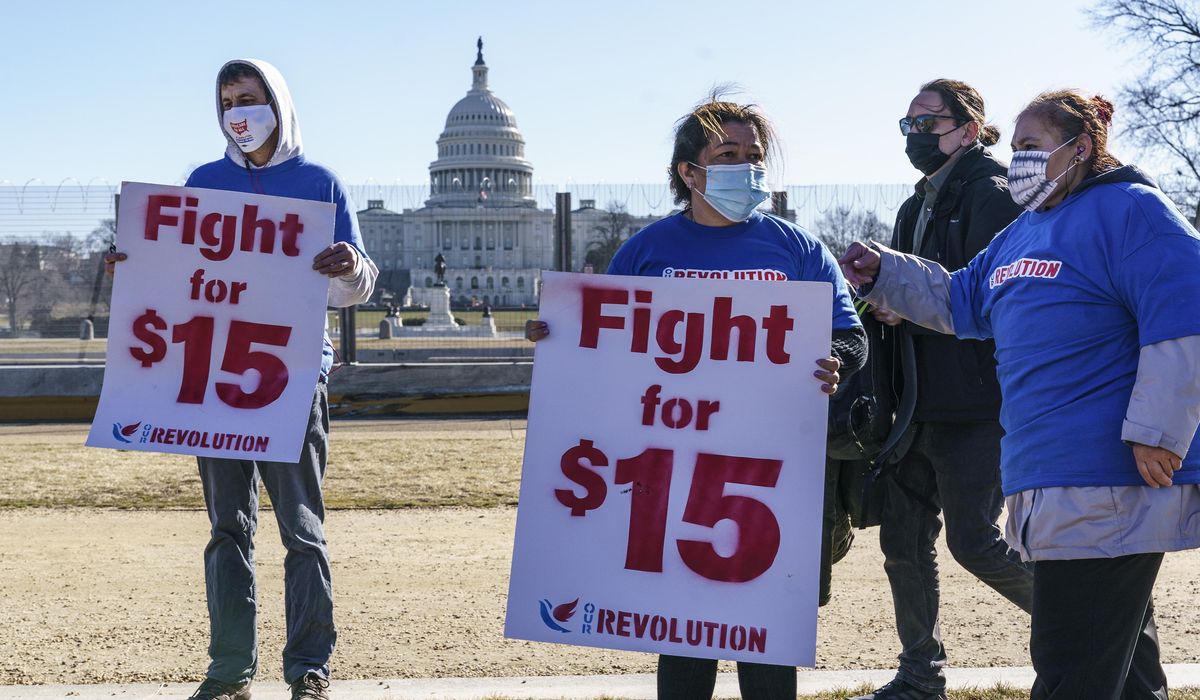
Minimum-wage workers across much of the country are set to see bigger paychecks this year as 25 states and the District of Columbia phase in higher wage requirements for employers.
Most of those 26 jurisdictions have bumped the federal minimum wage of $7.25 an hour for non-tipped workers, which hasn’t been increased since 2009, to at least $10 an hour.
The laws took effect in 20 states on Jan. 1. Another three states will raise the rate on July 1, and Florida will do so on Sept. 30. New York raised its minimum wage from $12.50 to $13.20 per hour on Dec. 31.
Brian Marks, who teaches economics at the University of New Haven, said the hikes continue a “trend of legislatively scheduled state minimum wage increases” above the federal minimum wage for nonexempt employees.
He said the increases, intended to secure living wages and motivate job seekers during a labor shortage, may prove ineffective. The supply chain crisis and other pandemic factors, he said, have led many employers to raise their minimum pay well above the new state targets.
“Most entry-level workers are already earning more than the minimum wage because employers are having to pay more during the pandemic to fill open positions,” Mr. Marks said. “For example, many fast-food restaurants are either already paying their employees above the minimum wage or are purchasing equipment like self-serve fountain drink machines to eliminate employees.”
In 48 states, the share of workers making the local minimum is less than 2.8%, even when indexed for inflation. The two exceptions are Louisiana and South Carolina, where 3.4% and 4.4% of their respective workers earn the minimum wage.
Hans Dau, a supply chain analyst who runs the Mitchell Madison Group business consulting firm, said the increases will not affect many workers in most U.S. markets for this reason.
“Minimum wage laws are largely political theater as less than 1.5% of U.S. workers work at the minimum wage level,” Mr. Dau said. “There are few markets where minimum wage is a factor, and those probably employ much of the well over 5% of the workforce that is in the U.S. illegally.
On Saturday, Virginia hiked its minimum wage from $9.50 to $11 per hour — the largest increase in the nation this year.
Maryland raised its minimum wage from $11.75 to $12.50, the second year in a row that it upped hourly worker pay by 75 cents as part of a phase-in plan to increase the minimum each year until it reaches $15 in 2025.
California began the year by raising the state’s minimum wage from $14 to $15 per hour, the highest minimum wage outside the District of Columbia.
Four other states raised their minimum wages by at least $1 this year: Delaware, by $1.25 to $10.50 per hour, and Illinois, New Jersey and New Mexico by $1 to $12, $13 and $11.50, respectively.
Rick Manning, president of the Fairfax, Virginia-based Americans for Limited Government, said the higher wages could lead some businesses to hire more experienced workers than young people for entry-level work.
“It’s an attack on young people and their ability to learn how to work,” Mr. Manning said. “In today’s economic environment, where small businesses are struggling for survival with supply chain difficulties, the government raising the cost of labor will kill some businesses, put some employees who aren’t deemed worthy of the increased wages out of work, and increase automation like self-serve checkouts at Walmart and the grocery store.”
Mr. Manning, a Labor Department chief of staff for public affairs in the George W. Bush administration, said thousands of workers on the lower end of the wage scale lost their jobs in Seattle because of a 2014 city law that gradually raised the minimum wage for companies with more than 500 employees from $9 to $15 an hour.
“We know that in Seattle, the City Council raised the minimum wage with the expectation that workers would receive a significant pay increase,” Mr. Manning said. “Instead, a lot of restaurants paid the best-performing employees more than $15 an hour and laid off the worst-performing employees.”
On Jan. 2, 2020, Kate Rogers and Nick Wells reported for CNBC that the Seattle wage hike left businesses short-handed because employees opted to work fewer hours in a tight labor market.
CNBC noted that Democratic Party presidential candidates Bernard Sanders and Joseph R. Biden advocated raising the federal minimum wage to $15 an hour. Congress has yet to fulfill that wish.
President Biden issued an executive order in April to raise the minimum wage for federal contract workers to $15 an hour. The rule takes effect on Jan. 30.
The National Employment Law Project reports that 56 municipalities are also raising the minimum wage this year.
Mayor Muriel Bowser has announced that the District of Columbia will increase its hourly minimum wage to $16.10, among the highest in the nation, on July 1.
On Jan. 1, West Hollywood, California, raised the minimum wage for hotel workers to $17.64 an hour, the highest in the country.
The other states that raised their minimum wages, effective Saturday, were Missouri ($11.15, an 85-cent increase), Vermont ($12.55, an 80-cent increase), Washington ($14.49, an 80-cent increase), Massachusetts ($14.25, a 75-cent increase), Rhode Island ($12.25, a 75-cent increase), Arizona ($12.80, a 65-cent increase), Maine ($12.75, a 60-cent increase), South Dakota ($9.95, a 50-cent increase), Ohio ($9.30, a 50-cent increase), Montana ($9.20, a 45-cent increase), Minnesota ($10.33, a 25-cent increase), Colorado ($12.56, a 24-cent increase) and Michigan ($9.87, a 22-cent increase).
On July 1, Connecticut will raise its minimum wage by $1 to $14 per hour while Nevada and Oregon increase theirs by 75 cents to $9.50 and $13.50 per hour, respectively.
Florida will increase its minimum wage by $1, to $11 per hour, on Sept. 30.
Twenty-one states, including Texas, Pennsylvania, Indiana and Utah, have not raised their minimum wages above the $7.25 federal rate.
Five of these states — Alabama, Louisiana, Mississippi, South Carolina and Tennessee — have not adopted separate minimum wages. The federal minimum wage of $7.25 applies as well as in Georgia and Wyoming, which have state minimum wages below the federal level.
Christine McDaniel, a senior fellow at George Mason University’s Mercatus Center free market think tank, said many businesses will respond to minimum wage hikes this year by either raising prices for goods and services or reducing work hours.
“Overall, the empirical evidence on the employment effects of increasing the minimum wage is mixed at best,” said Ms. McDaniel, a former Treasury Department deputy assistant secretary.








